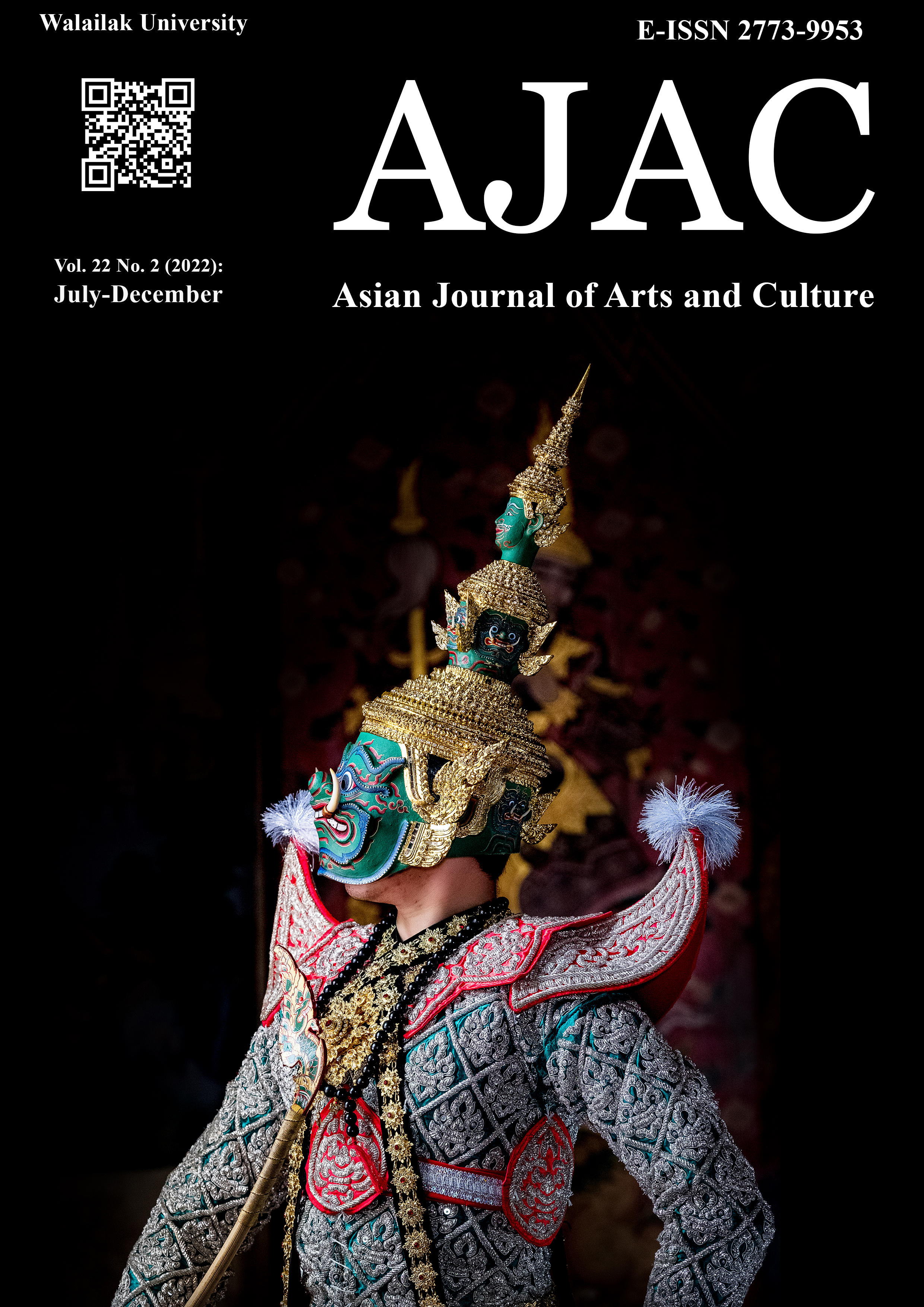The Creative of Dramatic Arts That Convey the Value of Cultural Capital and Promote the Creation of Added Commercial Value of Kalam Beads Through the Performance
Main Article Content
Abstract
This article was aims to study the creative forms of dramatic arts that convey the value of cultural capital. and promote the creation of added commercial value of Kalam beads through the Performance. The research team used qualitative research methodology and creative research conducting research by studying books academic documents, textbooks, journals and related research group discussions, information media, field trips, and field surveys and the experience of the researcher to analyze and design the process of creating works of dramatic art from the art of stringing Kalam beads to demonstrate the origin and development of Kalam beads. The results showed that the form of creation of works can be classified according to 8 elements of the show, namely 1) The performance design by defining the show format into 3 periods: the first period is the period that conveys the way of life of the villagers in the process of finding, natural colored glass to be used to make beads. Next, period 2 is the period that represents the 3 types of Kalam beads art. And the 3rd period represents the development and existence of Kalam beads at present through creative modifications to create added value. 2) The selection of actors based on the balanced physical characteristics and from the ability to perform appropriately with the acting style, making the performance more complete. 3) The design of the dance style is determined. It uses dance moves that are adapted from the Nora dance, combining movements from the dance language and natural body language to demonstrate the show's identity. 4) The sound design and the music used in the performance is a combination of southern folk music, Nora poem, and international music using electronic systems to blend in. 5) Costume design with an emphasis on modified and creative accessories, it has been developed from the Nora costume that has been applied to be more modern and suitable for the show. 6) The design of the performance equipment by simulating the tools used for finding natural colored glass to make beads, such as the hoe, spade and liang (the gem dredging plate), to give viewers a clearer picture and create a better understanding of the story in the presentation. 7) Lighting design for the show to convey emotion and support the atmosphere of the show to be more complete. Emphasis is placed on using bright lights and additional dyeing to show off the dance moves and to show off the decorations made from Kalam beads. Set a flashing light for each stage of the show. 8) Display area design, the emphasis is placed on the focus and the background to make the story more complete.
Article Details

This work is licensed under a Creative Commons Attribution-NonCommercial-NoDerivatives 4.0 International License.
© 2018 by Asian Journal of Arts and Culture, Walailak University. All rights reserved.
References
Aneksuk, B. (2015). Development of tourism formats and products in Phitsanulok Province to support Thai tourists and tourists in Proceedings of The 5thBurapha University International Conference 2016. (pp. 583- 599). Chonburi, Thailand: Burapha University.
Chantanasaro, T. (2014). Dance from the trinity concept in Buddhism. (Ph.D. Dissertation, Chulalongkorn University, Thailand).
Charassri, N. (2005). History of western dance. Bangkok, Thailand: Chulalongkorn University.
Cooper, S. (2016). Staging Dance. London, United Kingdom: A&C Black (Publishers) Limited.
Department of Cultural Promotion. (2017). Cultural Master Plan. Retrieved from https://www.egov.go.th/th/online.
Ministry of Culture. (2009). National Cultural Master Plan (2007-2016). Bangkok, Thailand: Office of Policy and Strategy.
Norratputthi, K. (2020). Dress with beads, sequins, pattern Nora costume. Retrieved from http://article.culture.go.th/index.php/layouts-modules-positions/3-column-layout-3/200-2020-04-08-09-18-45
Office of the National Economic and Social Development Board. (2017). National Economic and Social Development Plan No. 12 (2017 – 2021). Retrieved from https://www.nesdc.go.th/nesdb_en/ewt_w3c/ewt_dl_link.php?filename=develop_issue&nid=4345
Poonpakdee, N. (2019). The Creation of a Dance from Magic Tricks. (Ph.D. Dissertation, Chulalongkorn University, Thailand).
Rittibul, P., Mongkonprasert, S., Longchum. K,.(2021). The Model Creation of Dance Representing the Usefulness of the Jewel Beetle’s Wings and Economic Value-Adding Promoting Through the Performance. Institute of Culture and Arts Journal Srinakharinwirot University, 22(2), 125-139.
Rungthanapirim,T. (2017). The Theory of Beauty. Bangkok, Thailand: At Four Print.
Saitongkum, J. (2018). The Creative Process of Thai Dramatic Art Sakkaratwarat Dance. Research and Development JournalSuan Sunandha Rajabhat University, 10(1), 103-117.
Wisedsing, S. (2015). Flavor of Thai Dance Through the Modern Performance Narai Avatara. Institute of Culture and Arts Journal.15(2), 135-140.


